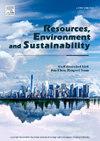Intercropping achieves long-term dual goals of yield gains and soil N2O emission mitigation
IF 12.4
Q1 ENVIRONMENTAL SCIENCES
引用次数: 0
Abstract
Mitigating nitrous oxide (O) emissions from agricultural soil is imperative for addressing climate change. Although diversified cropping systems have the potential to augment yields, their impact on soil O emissions over a long-term scale remains inconclusive. We measured crop yield and soil O emissions across eight consecutive years based on a positioned plot field experiment, using a constructed monocropping system as a control. We found that maize–potato intercropping after nitrogen (N) fertilisation elevated crop yields by 0.6 Mg ha−1 to 1.2 Mg ha−1 and decreased area- and yield-scaled O emissions by 5.2%–14.5% and 19.0%–20.6%, respectively, compared with the expected monocropping. Furthermore, the intercropping-induced O emissions reduction was more pronounced in the initial phase (first 3 years) and stabilised at a lower level in the later phase (last 5 years); it increased with N application rates. The altered nosZ gene abundance and nitrate-N (NO-N) content in soil, alongside N uptake by crops, primarily contributed to the O emission reduction after intercropping. The results confirm that long-term intercropping has a positive, but cropping duration-dependent, effect on yield gain and O emission mitigation. This offers a valuable reference for employing crop diversification to simultaneously address food security and climate change.

间作实现了提高产量和减少土壤N2O排放的长期双重目标
减少农业土壤中的一氧化二氮(N2O)排放对于应对气候变化至关重要。尽管多样化种植制度有可能增加产量,但其对土壤N2O排放的长期影响仍不确定。我们使用构建的单作系统作为对照,基于定位样地试验,连续8年测量作物产量和土壤N2O排放。研究发现,与预期的单作相比,施氮后的玉米-马铃薯间作使作物产量提高了0.6 ~ 1.2 Mg ha - 1,按面积和产量计算的N2O排放量分别减少了5.2% ~ 14.5%和19.0% ~ 20.6%。此外,间作引起的N2O排放量减少在初始阶段(前3年)更为明显,在后期(最后5年)稳定在较低水平;随施氮量的增加而增加。nosZ基因丰度和土壤硝态氮(NO3−-N)含量的改变,以及作物对氮的吸收,是间作后N2O排放减少的主要原因。结果表明,长期间作对作物增产和减少N2O排放具有积极的影响,但与种植时间有关。这为利用作物多样化同时解决粮食安全和气候变化问题提供了有价值的参考。
本文章由计算机程序翻译,如有差异,请以英文原文为准。
求助全文
约1分钟内获得全文
求助全文
来源期刊

Resources Environment and Sustainability
Environmental Science-Environmental Science (miscellaneous)
CiteScore
15.10
自引率
0.00%
发文量
41
审稿时长
33 days
 求助内容:
求助内容: 应助结果提醒方式:
应助结果提醒方式:


